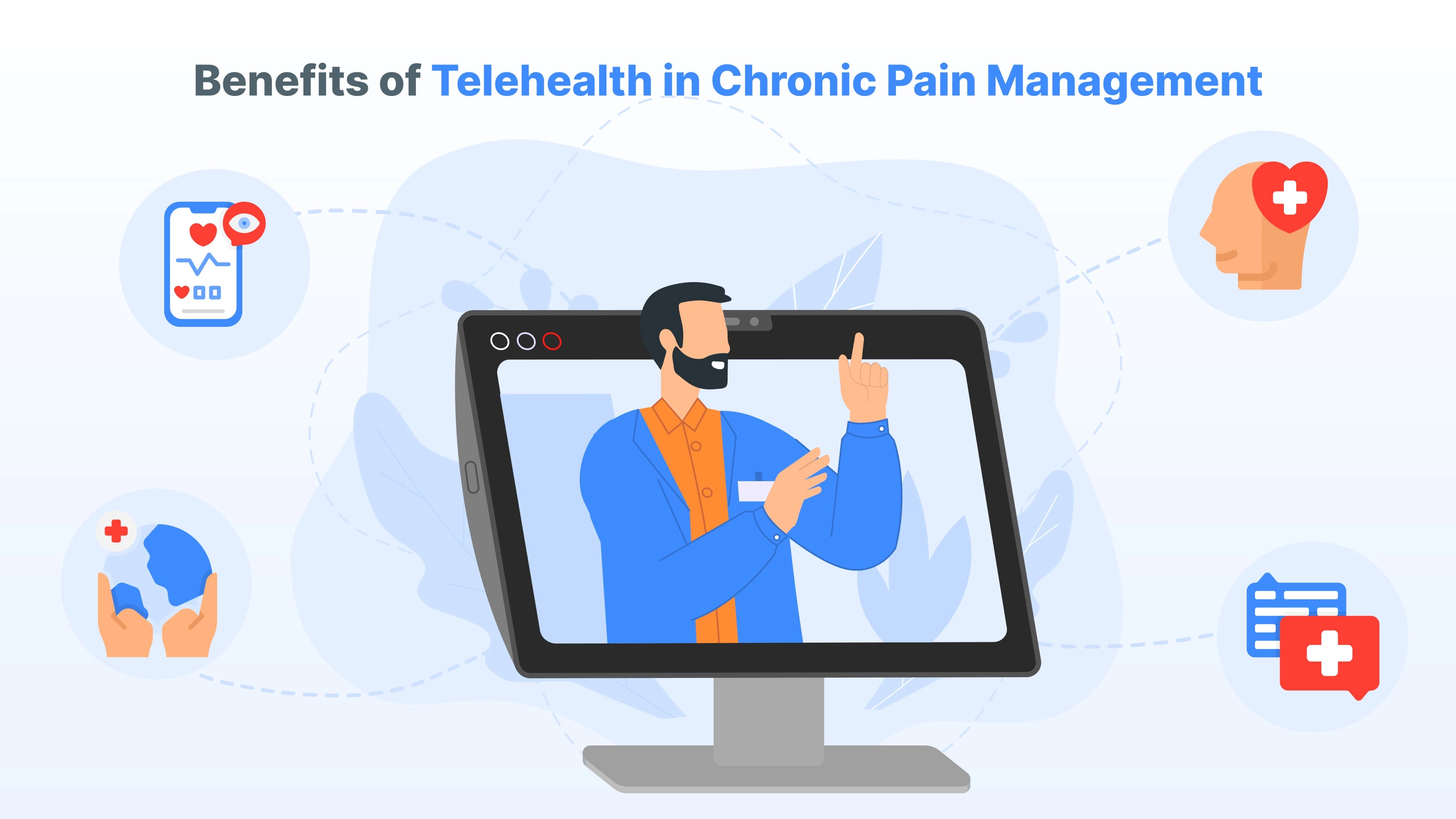

Chronic Pain Management Using Telehealth
Chronic pain is a persistent and often debilitating condition that affects millions of individuals worldwide. Managing chronic pain effectively is a critical aspect of healthcare, and it's a challenge that can greatly benefit from the innovative use of telehealth services. In this article, we’ll explore how telehealth is revolutionizing the field of chronic pain management, making it more accessible and convenient for patients while offering new avenues for healthcare providers to deliver effective care.
Telehealth: A Game-Changer in Healthcare
Telehealth, often hailed as a game-changer in healthcare, has undoubtedly brought about several significant benefits. However, it’s essential to recognize that while it has the potential to revolutionize healthcare, there are still limitations and concerns to be addressed.
Advantages of Telehealth
Increased Accessibility: Telehealth has expanded access to healthcare services, especially for individuals in rural or underserved areas. It bridges the gap by allowing patients to consult with healthcare providers remotely, reducing travel time and costs.
Convenience for Patients: Patients can now schedule appointments, receive consultations, and monitor their conditions from the comfort of their homes. This added convenience is particularly valuable for those with mobility issues or chronic pain, who may find in-person visits challenging.
Cost Savings: Telehealth can result in cost savings for both patients and healthcare systems. It reduces the need for physical infrastructure, such as clinics and hospitals, and can be more affordable for patients in terms of travel expenses.
Timely Consultations: Telehealth provides faster access to healthcare professionals, reducing wait times for appointments and enabling more immediate responses to patient concerns.
Realistic Concerns
Digital Divide: While telehealth has the potential to increase access, it’s crucial to acknowledge the digital divide. Not everyone has access to the necessary technology or a reliable internet connection, making it challenging for some individuals to benefit fully.
Quality of Care: Remote consultations may not always provide the same level of care as in-person visits. There are limitations to what healthcare professionals can assess and diagnose without physical interaction.
Data Security: The exchange of medical information online raises concerns about data security and patient privacy. Ensuring the confidentiality and integrity of patient information remains a significant challenge.
Regulatory and Licensing Hurdles: Telehealth services often encounter legal and regulatory barriers that vary from one region to another. Healthcare providers must navigate complex licensing and reimbursement issues.
Technological Challenges: Telehealth relies on technology, and technical issues, such as connectivity problems or software glitches, can disrupt patient care and lead to frustration.
Telehealth has made considerable progress in transforming healthcare, offering enhanced accessibility and convenience. However, it's essential to approach these advancements with a realistic view, acknowledging the existing challenges and limitations that still need to be addressed to fully realize its potential.
Chronic Pain Management
Chronic pain is a multifaceted healthcare challenge, and understanding its intricacies is crucial for effective management. In this section, we will explore chronic pain in more detail, compare traditional approaches to pain management with the innovative methods telehealth brings to the table, and highlight the key benefits of using telehealth in this context.
Understanding Chronic Pain
Chronic pain is a complex and often debilitating condition that persists for extended periods, typically exceeding three to six months. It can result from a variety of underlying causes, including injuries, medical conditions, or even unknown origins. Managing chronic pain is notoriously challenging due to its persistent nature and the individualized experiences of patients.
Types and Causes of Chronic Pain
Chronic pain comes in various forms, each with its unique characteristics and underlying causes. It can be neuropathic pain, which results from nerve damage, or nociceptive pain, which stems from tissue damage. Understanding the type of pain is essential for tailored management.
Challenges in Managing Chronic Pain
Traditional approaches to chronic pain management often involve a combination of medication, physical therapy, and in-person consultations with healthcare providers. However, these approaches have their challenges, such as:
Burdensome In-Person Visits: Frequent in-person visits can be cumbersome, especially for patients with limited mobility or those living in remote areas.
Limited Access to Specialists: Many chronic pain patients require the expertise of pain specialists, who might not be readily available in their geographical area. This can lead to delays in diagnosis and treatment.
Incomplete Understanding: Traditional methods may not always provide a comprehensive understanding of a patient’s pain. Some aspects of pain are subjective.
Benefits of Telehealth in Chronic Pain Management

Telehealth is changing the landscape of chronic pain management, offering new avenues for improving patient care. Here are some key benefits:
Reduced Geographic Barriers: Telehealth eliminates the need for patients to travel long distances for consultations. This is particularly valuable for individuals in remote areas, making specialist care more accessible.
Regular Monitoring: Telehealth enables the regular monitoring of patients’ pain levels and treatment progress through the use of mobile apps and wearable devices. This data helps healthcare providers make more informed decisions.
Customized Treatment Plans: Telehealth allows for more personalized treatment plans. Physicians can tailor interventions to suit individual patient needs and continually adjust the plan as necessary.
Mental Health Integration: Telehealth also facilitates the integration of mental health support into chronic pain management. Chronic pain often leads to mental health challenges, and teletherapy can address these issues in a convenient manner.
Telehealth, with its ability to overcome geographic barriers and offer personalized care, is emerging as a transformative tool in improving the quality of life for chronic pain patients. While it’s not a panacea, it’s a promising approach that deserves consideration in the broader context of pain management.
Telehealth Tools for Chronic Pain Management
Telehealth leverages a range of digital tools and technologies to enhance chronic pain management. These tools not only improve the patient experience but also provide healthcare providers with valuable data for more effective treatment.
Remote Consultations
Role: Telehealth platforms offer secure and convenient channels for remote consultations with healthcare providers. Patients can discuss their chronic pain, receive medical advice, and get prescriptions without the need for an in-person visit.
Benefits:
Convenience: Patients can access expert care from the comfort of their homes, reducing the burden of travel, especially for those with mobility issues.
Timely Access: Telehealth ensures that patients can consult with healthcare providers promptly, helping to address pain issues in real time.
Follow-Up Care: It allows for regular follow-up appointments, which are crucial in monitoring and adjusting treatment plans.
Monitoring and Tracking Apps
Role: Mobile apps and wearable devices play a vital role in tracking chronic pain symptoms, medication adherence, and overall health. Patients can record pain levels, medication intake, exercise routines, and other relevant data.
Benefits:
Data-Driven Decisions: Healthcare providers can access patient-generated data to understand pain trends and make informed decisions about treatment adjustments.
Engagement: These apps engage patients in their care by encouraging them to monitor and track their progress actively.
Early Intervention: Abnormal trends in data can trigger alerts for healthcare providers, enabling early intervention.
Teletherapy and Mental Health Support
Role: Chronic pain often coexists with mental health issues, such as depression and anxiety. Teletherapy services, including video sessions with mental health professionals, offer holistic support for patients.
Benefits:
Comprehensive Care: Addressing mental health alongside physical health improves the overall well-being of chronic pain patients.
Accessibility: Patients can access mental health support without the need to travel to a separate mental health clinic.
Stress Reduction: By addressing mental health issues, teletherapy helps patients better cope with pain, improving their quality of life.
Medication Management Platforms
Role: Telehealth platforms can provide tools for managing medications, including reminders for prescription intake, potential interactions, and tracking of medication effectiveness.
Benefits:
Adherence: Medication management tools promote adherence to prescribed medications, ensuring that patients get the full benefit of their treatment.
Minimizing Side Effects: Tracking medication effectiveness helps identify any side effects or the need for adjustments in medication.
Safety: Patients receive alerts for potential drug interactions or contraindications, reducing the risk of adverse events.
Education and Resources
Role: Telehealth platforms can offer educational materials and resources related to chronic pain management. These resources can include articles, videos, and interactive content.
Benefits:
Empowering Patients: Education equips patients with knowledge and self-care strategies to manage their pain effectively.
Patient Activation: Informed patients are more engaged in their care, making them partners in the pain management process.
24/7 Accessibility: Patients can access information at their convenience, facilitating ongoing learning.
Patient-Centered Care
Patient-centered care is a crucial aspect of chronic pain management, and telehealth provides a platform to make this approach more effective.
Tailored Treatment Plans
Role: Patient-centered care involves tailoring treatment plans to meet individual patient needs. Telehealth platforms allow healthcare providers to create personalized treatment plans based on the patient’s unique pain experience, preferences, and goals.
Benefits:
Improved Outcomes: Tailored plans are more likely to address the specific pain issues and needs of each patient, leading to better outcomes.
Patient Engagement: When patients have a say in their treatment plans, they become more engaged and motivated to adhere to them.
Flexibility: Plans can be adjusted as necessary based on the patient’s progress and changing pain patterns.
Improved Access to Specialists
Role: Regardless of their location, patients can connect with experts in the field, which is especially valuable for those in underserved or remote areas.
Benefits:
Expert Consultations: Patients can receive expert advice and specialized care that may not be readily available locally.
Reduced Wait Times: Access to specialists is often faster through telehealth, reducing the time patients must wait for consultations.
Second Opinions: Telehealth provides the option for patients to seek second opinions from specialists, offering a broader perspective on their condition.
Real-Time Feedback
Role: Telehealth allows patients to provide real-time feedback on their treatment progress, pain levels, and any side effects. This feedback loop is essential for fine-tuning treatment plans.
Benefits:
Data-Driven Decisions: Healthcare providers can make data-informed decisions about the patient’s care, addressing any issues promptly.
Personalized Adjustments: Real-time feedback enables healthcare providers to make timely adjustments to treatment plans.
Quality of Life: Patients experience a better quality of life as their pain management plan is continually refined based on their feedback.
Challenges and Considerations
Telehealth, despite its potential, faces several challenges and considerations in the context of chronic pain management. Here, we’ll explore these hurdles and issues that need to be addressed for telehealth to reach its full potential:
Regulatory and Legal Issues
Telehealth operates across state and international borders, making it subject to a complex web of regulations. Licensing, reimbursement, and legal frameworks can vary greatly from one location to another, creating obstacles for healthcare providers and patients alike.
Solution: Advocacy for standardized regulations and streamlined licensing processes can help remove these barriers, allowing telehealth to operate more smoothly and consistently.
Data Security and Privacy
The exchange of sensitive medical information over digital platforms raises concerns about data security and patient privacy. Protecting electronic health records from cyber threats is a critical consideration in telehealth.
Solution: Ensuring robust data encryption, secure connections, and compliance with healthcare data privacy laws (such as HIPAA in the United States) is essential to maintaining patient trust in telehealth.
Technological Barriers
Access to and proficiency with technology remain a significant barrier, particularly for elderly patients and those in underserved communities. A lack of reliable internet connectivity can disrupt telehealth consultations.
Solution: Bridging the digital divide requires efforts to improve technology access and digital literacy among all patient populations. Government and private sector partnerships can help expand broadband access to remote areas.
Conclusion
The integration of telehealth into chronic pain management represents a transformative step forward in healthcare. While challenges exist, the benefits are undeniable, and telehealth has the potential to significantly improve the lives of chronic pain patients. Telehealth is not a replacement for traditional in-person care, but rather a complementary approach that can overcome geographic barriers, promote patient engagement, and personalize treatment plans. It empowers patients to take an active role in their pain management, offers timely access to specialists, and integrates mental health support into care plans. With the right support and ongoing efforts to improve these aspects, telehealth can play an increasingly vital role in the comprehensive management of chronic pain, ultimately improving the quality of life for countless individuals.
Faq
How does telehealth assist in the management of chronic pain?
+Telehealth helps manage chronic pain by enabling patients to consult with healthcare providers remotely, facilitating ongoing monitoring and adjustments to treatment plans. Patients can receive expert guidance, access pain management strategies, and obtain prescriptions for medications without the need for in-person visits. This convenience improves the overall quality of life for individuals dealing with chronic pain.
What are the core components of a telehealth program for chronic pain management?
+A telehealth program for chronic pain management typically includes remote consultations, leveraging video or teleconferencing technology. It incorporates personalized pain management strategies, often combining medication management, physical therapy, and psychological support. Additionally, it should feature robust patient education and self-management tools to empower individuals to understand and manage their chronic pain effectively.
Can remote consultations effectively assess and address chronic pain conditions?
+Remote consultations can be effective in assessing and addressing chronic pain conditions by allowing healthcare providers to gather information about a patient’s medical history, symptoms, and functional status. However, the effectiveness may vary depending on the nature and severity of the condition, and some physical examinations or diagnostic tests may be limited. It’s important to ensure clear communication and collaboration between patients and healthcare professionals to develop comprehensive treatment plans.
Tell us about your project
Fill out the form or contact us

Tell us about your project
Thank you
Your submission is received and we will contact you soon
Follow us
